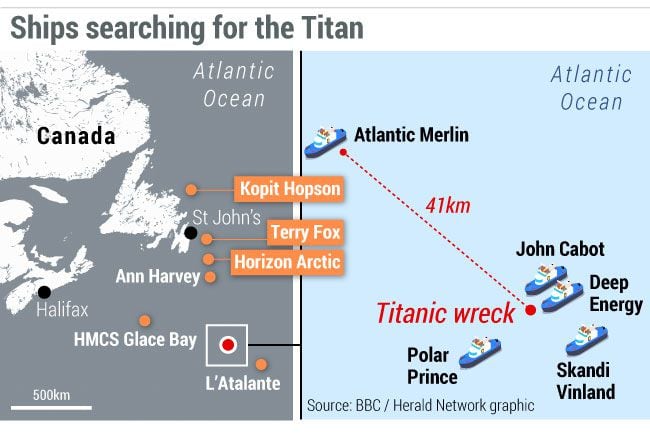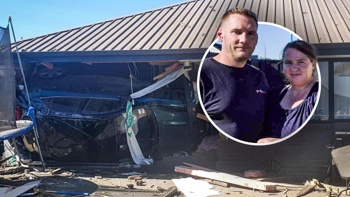The survivor of a submarine that sank half a century ago has described his experience of being trapped underwater and rescued just 12 minutes before his oxygen ran out.
Roger Mallison survived the sinking of Pisces III in 1973 after an about 80-hour rescue mission and has told Sky News the search for the submersible vessel missing on a trip to the Titanic’s wreckage is “horrendous”.
More aircraft, ships and underwater equipment from the US, Canada and France today searched for Titan, the small craft named owned by undersea exploration company OceanGate Expeditions.
The US Coast Guard has been leading the search since the Titan disappeared on Monday in a remote area of the North Atlantic Ocean.

Mallison and his colleague Roger Chapman were on board Pisces III laying a telephone cable under the seabed and as they surfaced a tow rope pulled open a hatch, letting in water.
Pisces III then sank to the bottom of the ocean off the coast of Ireland. Mallison and Chapman huddled together for warmth for about 84 hours.
“Neither of us really thought we were going to get out,” Mallinson said afterwards.
“You knew you had as much time as when your life support ran out, and that would be it.”
/cloudfront-ap-southeast-2.images.arcpublishing.com/nzme/JYPHIK2SR5GC3CJHRH3MOGYUFY.jpg)
Divers begin to open the hatch of the miniature submarine Pisces III as she breaks water under the John Cabot after being hauled from the Atlantic seabed off Cork. Photo / Getty Images
When Mallison and Chapman were rescued with only 12 minutes of oxygen left, they had little food on board and only had a plastic bag to use as a toilet.
“We just had to really ration everything and look after each other. We looked after each other and that was the major lifesaver,” Mallison told Sky News.
“We certainly did [think we wouldn’t make it]. Eighty-four hours is a very long time and we didn’t have enough food, we didn’t have enough oxygen, we didn’t have enough battery power to run a scrubber [CO2 removal device].”
Another submersible, Pisces V, eventually found Chapman and Mallison.
/cloudfront-ap-southeast-2.images.arcpublishing.com/nzme/Z4C7ZLGKD5E6XEPKQWHVJMIVUA.jpg)
Roger Mallinson (left), and Roger Chapman watch as a bottle of champagne is opened after their rescue from the Atlantic seabed. Photo / Getty Images
When Pisces V’s lights hit Pisces III the pair were moved to tears, but the rescue wasn’t simple, with the rescue craft also springing a leak and having difficulty attaching a rope.
Chapman recounted the moment they finally reached the surface: “The hatch was opened and there was sunlight streaming in from above. Voices spoke and hands reached down.”
It is the deepest underwater rescue ever achieved.
What’s the latest in the search for Titan?
A Canadian aircraft detected underwater noises in the search area over the past two days, according to the US Coast Guard.
Officials said they don’t know what made the sounds, and a robotic vessel scouring the area so far has “yielded negative results”. Additional remotely operated vessels were sent.
“The equipment that is on-site and coming is the most sophisticated in the world and certainly capable of reaching those depths,” said Sean Leet, chief executive of Canadian company Horizon Maritime.
As of today, searchers had covered an area twice the size of Connecticut in waters 4km deep.
/cloudfront-ap-southeast-2.images.arcpublishing.com/nzme/QMPS7SEGEZHTPJ3QE4QLOLFP6Q.jpg)
Capacities and capabilities of the Titan submersible.
The craft submerged on Monday and its support vessel lost contact with it about an hour and 45 minutes later, according to the Coast Guard.
The vessel was reported overdue about 700km south of St John’s, Newfoundland, according to Canada’s Joint Rescue Coordination Centre in Halifax, Nova Scotia.
The Titan was launched from an icebreaker that was hired by OceanGate and formerly operated by the Canadian Coast Guard. The ship has ferried dozens of people and the submersible craft to the North Atlantic wreck site, where the Titan has made multiple dives.
Experts say the best-case scenario would be finding the Titan on the ocean’s surface. It is equipped with safety systems to help it rise to the surface during an emergency even if everyone on board is unconscious.
If the Titan is stuck on the ocean floor, however, the occupants would eventually run out of oxygen and develop hypothermia from extreme cold. The vessel also could be caught in a fishing net or other entanglement.
In those cases, the best chance to reach it could be to use a remotely operated robot on a fibre optic cable, said Jeff Karson, a professor emeritus of earth and environmental sciences at Syracuse University.
A breach of the Titan’s hull at depth would mean instant death from the heavy pressure in the deep ocean. Still, a US Coast Guard official said the efforts to find the vessel remained a “search and rescue mission, 100 per cent”.
Joyce Murray, Canada’s Minister of Fisheries, Oceans and the Canadian Coast Guard, echoed that sentiment.
“We have to retain hope as part of what we are doing as a human community to find the explorers and bring them to safety,” she said.
A US Navy official today said that a special naval salvage system that could be used to haul the Titan to the surface had arrived in St. John’s. Officials were in the process of identifying a vessel that it could be attached to and once one is chartered, it would take about 24 hours to weld the system to the deck.
Take your Radio, Podcasts and Music with you









